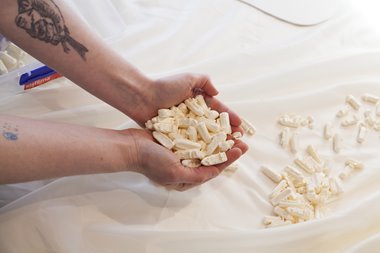 High Tide 17: Placing a City
High Tide 17: Placing a City
words by Nyanda Smith
Anthropologist Marc Augé famously describes the contemporary globalised social condition as fragmented, with its plethora of ‘non-places’, that are neither ‘relational, historical [or] concerned with identity’.[i] High Tide 17, the first instalment of a new Fremantle contemporary art biennale, can be seen as offering a purposeful antidote to Augé’s proposition, providing a two-week conduit for communal engagement with place through site-responsive, specific, and participatory artworks.
Founded by Tom Mùller and a small Fremantle-based team that includes Corine van Hall, Pete Stone and Ric Spencer, the premise of the event is the exploration of Fremantle as place(s). Artists, both local and from further afield have been invited to create works in a careful selection of interior and exterior, public, commercial and institutional spaces dotted throughout the city’s West End. Sites encompass those within well-trodden pedestrian paths, others in spaces commonly closed to the public.
By making room for what Gillian McIver describes as two-way ‘encounters’ with site — where its ‘geography, locality, topography, community, history’[ii] provides for the realisation of the works — the High Tide 17 initiators seem to be interested in galvanising a concentrated consideration of meanings of place. The examination will extend from the artist’s engagement with their accorded sites, to intentional audiences, to the disparate publics frequenting the city going about their ‘daily spatial practices’[iii]. Scales of communities, both local: possessing lived experiences of the sites, and from afar: through participating visiting artists, are collaborators in the production of meaning.
The particular relationships generated between artists and communities in the realisation of site-based work is the focus of Artsource and UWA Cultural Precinct’s third annual visual arts symposium. Taking place over one day at Notre Dame University, HOME TOWN: Artist and community ambition on an international stage features a panel of Australian artists and curators based nationally and internationally. The discussion centres on ambitious international and local projects, and the role of community in terms of agency, history and permanency.
Two of a number of the Fremantle artists taking part in High Tide 17 are Artsource members Holly Story and Amy Perejuan-Capone, both of whom probe notions of place within their respective practices.
Holly Story
-2017-rope,-wooden.aspx?width=347&height=260) Rapunzel
Rapunzel
High Tide Hub, Arthur Head Reserve, 9 Captains Lane, Fremantle
4pm 2, 9 + 11 November 2017, Thursday + Saturday
Golden strands loop into a coiled viscous ball, gently perched upon the sand at the water’s edge: a washed-up, quietly ominous, offering.
Holly Story’s long-term enquiry consists of a close reading of the Western Australian landscape, with a focus on examining how one forges and reconciles an existence within it. Having moved from England in the 1970s, for the past three decades she has focused primarily on her new home, living variously between locations in the Great Southern and Fremantle.
Exploring interplays between the natural and cultured worlds — points of connection, synchronicity and tension — Story’s practice is an iterative, interrogatory process, working across printmaking, installation and sculpture. Through technique and media, using intensive processes including dye, stitch and twining and natural materials and found objects, her works evoke both the inhabited and ecological realms.
Narrative is never far away from the works: both informing, and hinted at within. Lately, Story has begun a process of animating the works: using video, and performance that incorporates storytelling, to create a new participatory dimension. ‘It is a fairly new departure. I was beginning to think that the work needed more than just sitting quietly in a gallery, that I wanted a deeper engagement with the audience,’ she explains. Michel De Certeau writes that stories ‘carry out a labour that constantly transforms places into spaces or spaces into places.’[iv] It is this function of narrative, as a transformative act for accessing place, that Story can be seen to be harnessing.
Having long drawn from Western scientific and botanical knowledge to unpick understandings of the South-West, Story has in recent years focused on learning about Noongar culture, language and stories, working with the Noongar elder Noel Nannup, and teacher Sharon Gregory. ‘It was something that was lacking from my discussion of place, I didn’t quite know how to approach it. The whole landscape shifts when you start to get that glimpse into Noongar life and language here.’
It is this way into landscape that has provided Story impetus for her performance installation Rapunzel (canola story), to be shown as part of High Tide 17. The genesis for the work originates in a group walk that Story undertook in 2014 organised by PhD candidate Ailsa Grieve, with Nannup, following a Noongar story through country. ‘The story starts at Rottnest and ends at Uluru, and I walked the stage in the Wheatbelt, from York to Yorkrakine Rock, a women’s traditional birthing site. This was when the importance of story in country really woke up for me, that stories are about mapping the country, they are a whole picture of where you are.’
Walking through hectares of canola fields, Story describes as an experience of dualisms — the crops sensorially captivating for their vivid golden hues, yet darkly loaded as representation of degradation of landscape. Further, as food production, they symbolise the contemporary reality of how we live within, and from, our land.
‘This awful contradiction, is almost a metaphor for us being in this landscape — the beauty twinned with a sinister undercurrent. As in, we’ve done this so we are complicit in it, and responsible for where it goes from here.’
Story was moved to reconcile the crop’s potent symbology, through granting it its own narrative. A link to the folktale Rapunzel emerged, through a reference to the botanical plant name rapum, the Latin for turnip, of which Oilseed Rape — Brassica rapa — is a relative. Today’s Canola is a modern strain bred from rapeseed for human consumption. ‘Canola will have lots of stories, but this is the one I wanted to tell.’
-at-Bathers-Beach,-perform.aspx?width=277&height=210) The fable, first published by the Italian poet Giambattista Basile in the 15th century has been adapted and re-adapted across time and cultures, with the most prevalent the Germanic Brothers’ Grimm version from the 1800s, with its theme common to folklore — of ‘darkness, something fearful’.[v] At its centre, is a bitter verdant-leaved plant that induces desire, with consequences including baby-bargaining, containment of youth and fertility, and oppression of agency — with an emotional score of equal parts fear, vengeance and anguish. Resilience features, too. The resonance with canola, today, a geographical and temporal world away, is pertinent in the small transplant’s ramifications — emotions both metaphoric and real spilling over at the farm-gate, and beyond.
The fable, first published by the Italian poet Giambattista Basile in the 15th century has been adapted and re-adapted across time and cultures, with the most prevalent the Germanic Brothers’ Grimm version from the 1800s, with its theme common to folklore — of ‘darkness, something fearful’.[v] At its centre, is a bitter verdant-leaved plant that induces desire, with consequences including baby-bargaining, containment of youth and fertility, and oppression of agency — with an emotional score of equal parts fear, vengeance and anguish. Resilience features, too. The resonance with canola, today, a geographical and temporal world away, is pertinent in the small transplant’s ramifications — emotions both metaphoric and real spilling over at the farm-gate, and beyond.
The work Rapunzel (canola story) consists of a sculpture, a large golden plait, made from recycled rope. Nearby, Story orates the Rapunzel fable, recanting a permutation of her early childhood memory of the tale. Performed earlier this year at Bather’s Beach, where the plait was contained in an iron cage, Story is currently re-working the artwork for its new site of Arthur Head Reserve. The location, in front of the Round House, is itself imbued with deep dualisms — arrivals marked by dispossession, imprisonment, and new beginnings: new narratives. ‘It makes sense, as it is where things arrive in Fremantle and out into country.’
When I visit Story in her back-garden studio, the sculpture sits on a table, traces of salt and tiny tufts of sea-weed remaining, awaiting treatment. ‘She experienced a number of super high tides’, says Story. In an evolution with the installation’s migration around the corner, the plait will be unshackled from its cage. ‘The idea is that the work is shifting, as it progressively moves inland.’
The engagement possibilities of live art have initiated a new fecund phase for Story. Over three performances, a High Tide 17 audience will be part of an ephemeral experience: as performer, sculpture, audience and site synthesise in the actualisation of the piece. ‘It’s started this conversation around the work that is more than a visual response. I believe still very strongly in the power of looking and being with the work in that way, but this draws in people in another, different, way. I think that hearing the story gives people many more cues for their own imagining.’
Amy Perejuan-Capone
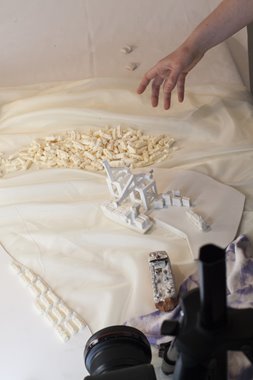 Fathom
Fathom
(Group show with Simryn Gill and Ariane Palassis)
PS Art Space (PSAS), 22 Pakenham Street, Fremantle
8 to 30 November, Tuesday to Sunday, 10am to 4pm
Opening: 6pm Wednesday 8 November
A process of observation as part of Amy Perejuan-Capone’s daily routine provides the source of a body of work that is both a method of personal orientation, and a homage to place. Her home in Fremantle provides an everyday front-window view of the Fremantle Harbour, and similarly her daily train commute to Perth, a closer view of the same subject. It is these viewpoints that Perejuan-Capone has drawn from to create a composite collection of objects.
A tradition exists of artists replicating man-made structural vernacular forms as a repeat methodology, such the work of Ed Ruscha, Callum Morton and Joanna Lamb — which can be seen as a form of personal visual semiosis. For her, Perejuan-Capone describes the approach as a conscious ‘positive feedback loop’, that acts as a meditation upon her affinity with both the aesthetic qualities of the structures, and what they represent to her.
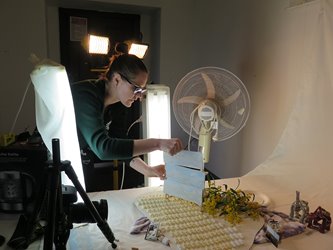 Perejuan-Capone studied visual art at Curtin University, working primarily in electronic art, before studying industrial design at North Metropolitan TAFE where she learnt furniture-making, 3D printing and computer-aided design. Today her practice draws from across this range of study. Her current work consists of miniature recreations of the Fremantle Harbour cranes, ships and platform, using ceramics, silversmithing and drawing. ‘I had started creating the visual language for a number of years, but with no defined end point, other than objects as objects’, Perejuan-Capone explains. ‘I then started experimenting with putting them together in a set-pieces for video or photography.’ For High Tide 17, these disparate objects will be presented as a picture-plane/diorama installation within the PSAS gallery.
Perejuan-Capone studied visual art at Curtin University, working primarily in electronic art, before studying industrial design at North Metropolitan TAFE where she learnt furniture-making, 3D printing and computer-aided design. Today her practice draws from across this range of study. Her current work consists of miniature recreations of the Fremantle Harbour cranes, ships and platform, using ceramics, silversmithing and drawing. ‘I had started creating the visual language for a number of years, but with no defined end point, other than objects as objects’, Perejuan-Capone explains. ‘I then started experimenting with putting them together in a set-pieces for video or photography.’ For High Tide 17, these disparate objects will be presented as a picture-plane/diorama installation within the PSAS gallery.
For Perejuan-Capone the components of the harbour are not only steeped in lived experience in terms of her daily visual perspective — but also strongly reference memory, as do her methods.
As a child, she was drawn to the industrial sphere through her dad’s work as a machinist. ‘He made train wheels for the Midland Railways, and he always had me in the shed making things with the lathe and metalworking.’ Similarly evoked are her mum’s craft-making and collecting of porcelain miniatures. ‘I feel like I am coming back to a lot of these processes because it’s comforting, they are in some way innate as they are processes that I have been raised with.’ Since she was a child she has also been captivated by railways, ships and motors.
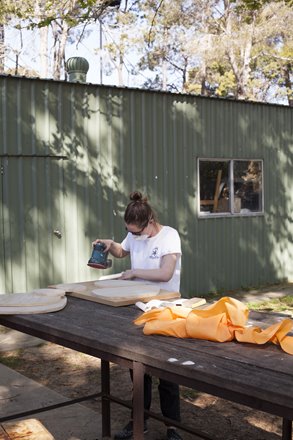
The objects are created in representational manner, but are not strictly accurate for likeness or scale. ‘They are an intuitive scale, as I see fit, and also determined by the material’. Slight silver ships are at jewellery-size, Raku container and roll-on roll-off ships are a larger childlike ‘toy size’ — immutable, with cracked spidery lines, in a muted primary palette. A series of porcelain cranes are intricate and refined, in a nod to collectable figurines.
The works allude to traditions of train and ship-spotting and miniature railway sets, which are part of a subcultural lexicon that Perejuan-Capone is drawn to, but stands aside to. ‘It’s not to say that I was ever discouraged in these things, but they remain remarkably closed to women.’ The approach of non-realism is a subversion of the masculinist territory of these realms. ‘My approach of making these personal-scale, blobby, feminine versions of this traditionally masculinised subject matter is my way of connecting with these big machines that I love so much.’
She has a particular affinity for the ubiquitous Norwegian shipping line Wallenius Wilhelmsen. ‘The orange ones in particular — the graphic design is just superb, the font is just perfect. I started affectionately calling them my “Wilhelm friends” and I knew it would be a good day if the orange ones were in.’
Within the PS Gallery Space, once a depot for the transport company Frank Manford and Co., the audience will be within close proximity to the harbour. ‘For the people that are familiar with the sight, it is most likely going to be a process of warm recognition. But for those that aren’t familiar with it, I hope that they will experience my layered, laborious, perspective — I want to convey that sense of connection, even though they aren’t literally recognising it.’
High Tide 17 takes place over two weeks. Like the thematic undulation of its title, over this time-period the city’s regular patterns will change: new spatial boundaries, movements and actions will occur. At the event’s close, the artworks across the city will retreat — with fresh stories having been written, and collective traces in memory remaining — adding new layers of cultural history to the sites. Layers for future people to uncover, perhaps.
Nyanda Smith is a writer and editor who lives in Fremantle.
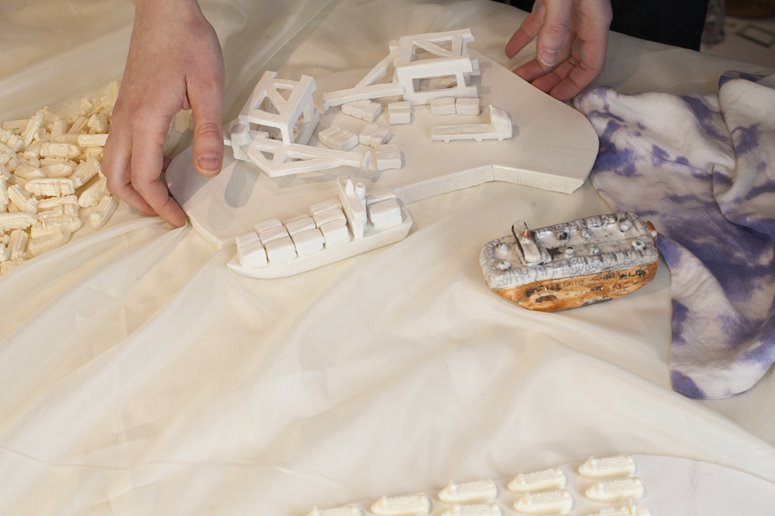
[i] Augé, Marc, Non-Places: Introduction to an Anthropology of Supermodernity, translated by John Howe, Verso, London, 1995, p. 77‒8.
[ii] McIver, Gillian, ‘Art/Site/Context’, Chapter 6, Homepage, http://www.sitespecificart.org.uk/6.htm. Accessed 1 October 2017.
[iii] De Certeau, Michel, The Practice of Everyday Life, University of California Press, Berkeley, 1984, p. 118.
[iv] De Certeau, Michel, The Practice of Everyday Life, University of California Press, Berkeley, 1984, p. 118.
[v] Maitland, Sara, Gossip from the Forest: The Tangled Roots of our Forests and Fairytales, Granta Publications, London, 2012, p. 204.
Images (top to bottom):
-
Amy Perejuan-Capone, in studio at Fremantle Arts Centre, 2017. Image courtesy of High Tide.
-
Holly Story, Rapunzel (canola story), 2017. Plaited jute, wooden pallet, wire basket, silk ribbon, 65 x 90 x 80 cm. Photograph: Colin Story.
-
Holly Story, Rapunzel (canola story), Performance at Bather’s Beach, March 2017. Photograph: Colin Story.
-
Amy Perejuan-Capone, in studio at Fremantle Arts Centre, 2017. Image courtesy of High Tide.
-
Amy Perejuan-Capone, in studio at Fremantle Arts Centre, 2017. Photography: Nyanda Smith.
-
Amy Perejuan-Capone, in studio at Fremantle Arts Centre, 2017. Image courtesy of High Tide.
High Tide 17
28 October to 12 November 2017
www.hightidefremantle.com
HOME TOWN
Artist and community ambition on an international stage
An Artsource and UWA Cultural Precinct Symposium
www.artsource.net.au/hometown
Rapunzel
by Holly Story
High Tide Hub, Arthur Head Reserve, 9 Captains Lane, Fremantle
4pm 2, 9 + 11 November 2017, Thursday & Saturday
Fathom
by Amy Perejuan-Capone with Simryn Gill and Ariane Palassis
PS Art Space, 22 Pakenham Street, Fremantle
10am to 4pm 8 to 30 November 2017, Tuesday to Sunday. Opening: 6pm Wednesday 8 November 2017